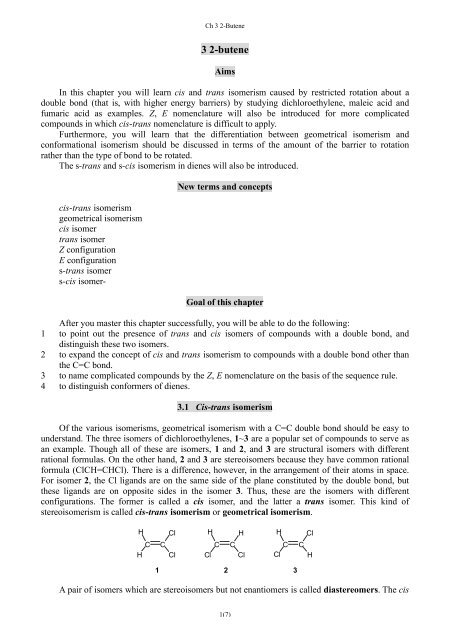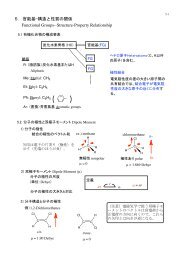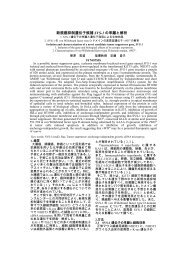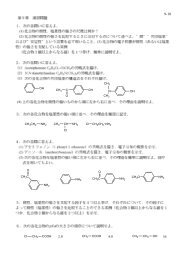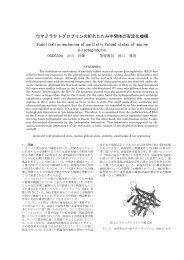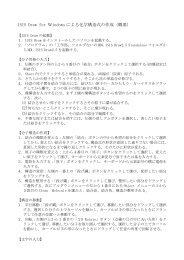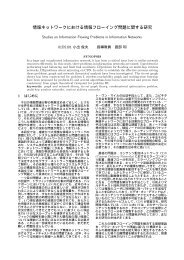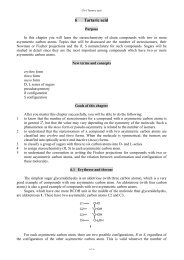3 2-butene
3 2-butene
3 2-butene
Create successful ePaper yourself
Turn your PDF publications into a flip-book with our unique Google optimized e-Paper software.
Ch 3 2-Butene<br />
3 2-<strong>butene</strong><br />
Aims<br />
In this chapter you will learn cis and trans isomerism caused by restricted rotation about a<br />
double bond (that is, with higher energy barriers) by studying dichloroethylene, maleic acid and<br />
fumaric acid as examples. Z, E nomenclature will also be introduced for more complicated<br />
compounds in which cis-trans nomenclature is difficult to apply.<br />
Furthermore, you will learn that the differentiation between geometrical isomerism and<br />
conformational isomerism should be discussed in terms of the amount of the barrier to rotation<br />
rather than the type of bond to be rotated.<br />
The s-trans and s-cis isomerism in dienes will also be introduced.<br />
cis-trans isomerism<br />
geometrical isomerism<br />
cis isomer<br />
trans isomer<br />
Z configuration<br />
E configuration<br />
s-trans isomer<br />
s-cis isomer-<br />
New terms and concepts<br />
Goal of this chapter<br />
After you master this chapter successfully, you will be able to do the following:<br />
1 to point out the presence of trans and cis isomers of compounds with a double bond, and<br />
distinguish these two isomers.<br />
2 to expand the concept of cis and trans isomerism to compounds with a double bond other than<br />
the C=C bond.<br />
3 to name complicated compounds by the Z, E nomenclature on the basis of the sequence rule.<br />
4 to distinguish conformers of dienes.<br />
3.1 Cis-trans isomerism<br />
Of the various isomerisms, geometrical isomerism with a C=C double bond should be easy to<br />
understand. The three isomers of dichloroethylenes, 1~3 are a popular set of compounds to serve as<br />
an example. Though all of these are isomers, 1 and 2, and 3 are structural isomers with different<br />
rational formulas. On the other hand, 2 and 3 are stereoisomers because they have common rational<br />
formula (ClCH=CHCl). There is a difference, however, in the arrangement of their atoms in space.<br />
For isomer 2, the Cl ligands are on the same side of the plane constituted by the double bond, but<br />
these ligands are on opposite sides in the isomer 3. Thus, these are the isomers with different<br />
configurations. The former is called a cis isomer, and the latter a trans isomer. This kind of<br />
stereoisomerism is called cis-trans isomerism or geometrical isomerism.<br />
H Cl H H H<br />
C C<br />
C C<br />
C<br />
H Cl Cl Cl Cl<br />
Cl<br />
C<br />
H<br />
1 2<br />
3<br />
A pair of isomers which are stereoisomers but not enantiomers is called diastereomers. The cis<br />
1(7)
Ch 3 2-Butene<br />
and trans isomers are not enantiomers, but diastereomers. The diastereomers in a pair are completely<br />
distinguishable by their different chemical and physical properties.<br />
Since rotation about a double bond in contrast to a single bond, is prohibited by the overlap of p<br />
orbitals, geometrical isomers can usually be isolated because their chemical and physical properties<br />
are generally different to some extent. For example, the melting and boiling points of trans-1,2-<br />
dichloroethylene 3 is –50 o C and 48.4 o C respectively, while those of cis-1,2-dichloroethylene 2 are<br />
–80.5 o C and 60.3 o C, respectively. Their densities (g cm -3 ) are 1.259 for 3, 1.265 for 2. Thus, these<br />
two compounds possess different properties.<br />
S3.1 cis-trans isomerism (geometrical isomerism)<br />
cis isomers: isomers with similar ligands on the same side of the double bond<br />
trans isomers: isomers with similar ligands on the opposite side of the double bond<br />
X<br />
Y<br />
X<br />
Y<br />
cis<br />
4 trans 5<br />
Q3.1<br />
Which of the following compounds possess geometrical isomers? Distinguish whether the one<br />
you indicated is trans or cis. Write the structure of the compound with an opposite configuration.<br />
□<br />
X<br />
C<br />
Y<br />
X X Y X Y X Z<br />
C C C C C C C<br />
Z Y X X Z Y W<br />
6 7 8 9<br />
Q3.2<br />
Fumaric acid and maleic acid are isomers with remarkably different physical properties (e.g.,<br />
melting point) as shown below. Interestingly, the heat of combustion of the cis isomer 14 is slightly<br />
higher than that of the trans isomer 13. This is a general phenomenon among cis isomers. Why?<br />
H COOH<br />
HOOC<br />
C C<br />
C C<br />
HOOC H<br />
H<br />
13 14<br />
COOH<br />
H<br />
286~287°C<br />
1337.6<br />
melting point<br />
heat of combusion( kJ mol -1 )<br />
130.5 °C<br />
1363.1<br />
□<br />
0.7 (17°c) solubility ( g/100g H 2 O )<br />
79 (25°C)<br />
A3.1<br />
6: cis isomer, the opposite isomer is 10<br />
7: trans isomer, the opposite isomer is 11<br />
8: there is no geometrical isomer<br />
9: impossible to decide. the opposite isomer is 12<br />
2(7)
Ch 3 2-Butene<br />
□<br />
X Z X X X W<br />
C C C C C C<br />
Y X Y Y Y Z<br />
10 11 12<br />
Q3.3<br />
One of 13 or 14 is converted into maleic anhydride 15, losing 1 mol of water, when heated to<br />
ca. 140 o C. However, the other one shows no change when heated to the same temperature, and it is<br />
finally converted into 15 when heated to about 275 o C. Explain this phenomenon, and identify<br />
whether 13 or 14 is converted to 15 more easily.<br />
O<br />
HC<br />
HC<br />
C<br />
C<br />
O<br />
O<br />
□<br />
15<br />
A3.2<br />
The heat of combustion of 14 is higher than that of 13 because the energy contained in 14<br />
should be larger than that in 13. (the products of combustion are the same). This is due to the<br />
increased potential energies caused by the two bulky carbonyl groups nearby.□<br />
Q3.4<br />
Are the following compounds cis or trans?<br />
□<br />
Cl<br />
H<br />
Br CH 3 CH 3<br />
H COOH C 6 H 5<br />
C C<br />
C C<br />
C C<br />
C C<br />
Cl C 2 H 5 H H 3 C CH 3 H<br />
16 17 18 19<br />
COOH<br />
C 6 H 5<br />
A3.3<br />
The one converted to 15 more easily is the cis isomer 14. It is necessary for two carboxy<br />
(-COOH) groups close together to yield maleic anhydride by loosing 1 mol of water from these two<br />
groups. 14 should be dehydrated more easily than 13, because the two carboxy groups are on the<br />
same side of the double bond.<br />
If the trans isomer 13 is to be converted to 15, a cleavage of the double bond should occur to<br />
yield a single bond. The subsequent rotation by 180 o and regeneration of a double bond takes place.<br />
Since the bond energy of a single bond and that of a double bond are different by 263 kJ mol -1 , a<br />
considerable amount of energy is required for such a process.<br />
3(7)
Ch 3 2-Butene<br />
H<br />
C<br />
C<br />
HOOC<br />
H<br />
13<br />
HOOC<br />
H<br />
C<br />
COOH<br />
C<br />
H<br />
COOH<br />
heat<br />
recombination<br />
H<br />
C<br />
HOOC<br />
HOOC<br />
C<br />
H<br />
C C<br />
H H<br />
14<br />
COOH<br />
COOH<br />
rotation<br />
□<br />
A3.4<br />
16 and 19 are cis isomers. 17 and 18 are trans isomers.<br />
Since each of these compounds possess a pair of the same ligands on each of the two carbon atoms<br />
forming the double bonds, it seems easy to classify these compounds (as long as we follow the<br />
principle of Q3.1). However, some questions may arise regarding this classification. For example,<br />
according to the rule of nomenclature, 17 should be 3-methyl-2-pentene rather than 2-ethyl-2-<strong>butene</strong>.<br />
Clearly trans isomer if 17 should be considered a pentene. As another example of uncertainty, when<br />
19 is regarded as a derivative of cinnamic acid C 6 H 5 CH=CHCOOH, it is cis. On the other hand, it<br />
should be classified as trans (the answer), if it is considered as a derivative of stilbene<br />
C 6 H 5 CH=CHC 6 H 5 .□<br />
3.2 E, Z nomenclature<br />
The cis-trans nomenclature involves some ambiguity as is shown in the examples given above.<br />
Cis-trans nomenclature is originally a trivial system that is useful when simple compounds are<br />
named. It is not useful, however, as a general nomenclature. Hence, a general nomenclature of<br />
geometrical isomers based on the sequence rule has been proposed. The procedure is as follows:<br />
1) Determine the priority of two ligands (including a lone pair) bonded to each atom of the double<br />
bond based on the sequence rule.<br />
2) Name the isomer, as indicated below, when the two ligands of higher priority are located on<br />
opposite sides of the double bond: E (abbreviation of entgegen) or seqtrans, and<br />
the same side of the double bond: Z (abbreviation of zusammen) or seqcis.<br />
S3.2 E, Z nomenclature<br />
E (or seqtrans): ligands with higher priority are placed on opposite sides of a double bond<br />
Z (or seqcis): ligands with higher priority are placed on the same side of a double bond<br />
(○ > ●, □ > ■)<br />
C<br />
C<br />
C<br />
C<br />
Z (seqcis)<br />
E (seqtrans)<br />
Prefixes such as seqcis and seqtrans are equal to cis and trans, respectively, in the sequence rule<br />
(SEQuence rule). Symbols Z and E are, however, exclusively used today.<br />
Q3.5<br />
Determine the priority of ligands on each carbon atom of 16-19 shown in Q3.4, and name each<br />
compound by the E, Z nomenclature.□<br />
4(7)
Ch 3 2-Butene<br />
Q3.6<br />
Draw the rational formula for each of the following compounds, and put a symbol ○ on<br />
compounds with cis-trans isomerism.<br />
(a) 1-<strong>butene</strong>, (b) 2-<strong>butene</strong>, (c) 2-methyl-2-<strong>butene</strong>, (d) 1,2-dibromo-1-propene,<br />
(e) 1,3-dibromo-2-<strong>butene</strong>□<br />
A3.5<br />
16: Br > Cl, Cl > H (Z), 17: C 2 H 5 > CH 3 (E), 18: COOH > CH 3 (E), 19: COOH > C 6 H 5 (Z)□<br />
Q3.7<br />
If the compounds in Q3.6 possess cis-trans isomers, write the structural formulas of its Z<br />
isomer.□<br />
A3.6<br />
(a) CH 3 CH 2 CH=CH 2 , (b) ○ CH 3 CH=CHCH 3 , (c) CH 3 CH=C(CH 3 ) 2 , (d) ○ CH 3 CBr=CHBr,<br />
(e) ○ CH 3 CBr=CHCH 2 Br□<br />
A3.7<br />
□<br />
H H CH 3 H CH 3<br />
(b)<br />
C C (d) C C (e) C C<br />
H 3 C CH 3<br />
Br Br Br<br />
20 21 22<br />
H<br />
( Br > CH 3 )<br />
CH 2 Br<br />
3.3 Configuration and conformation<br />
So far, the term conformers has been used to explain isomers related to rotation about the C-C<br />
single bond of ethane and butane derivatives and the term configuration to define some substituted<br />
methanes and ethylenes in the previous chapters. At first glance it seems straightforward to<br />
distinguish conformation and configuration. The stereoisomerism that is due to the rotation about a<br />
single bond is called conformation. Conformers are easily interconvertible and it is difficult to<br />
isolate the isomers. In contrast, when two compounds are different in their configurations, e.g., a<br />
pair of enantiomers of bromochlorofluoromethane, or a pair of geometrical isomers such as maleic<br />
acid and fumaric acid, these are distinguishable compounds, and their isolation is possible.<br />
However, if maleic acid can be converted into fumaric acid by heating, there remains some<br />
ambiguitiy in distinguishing conformational isomers and configurational isomers by the possibility<br />
of their interconversion. It would be more practical to classify them by the ease of interconverting<br />
them. A new nomenclature has been proposed where stereoisomers with a lower energy barrier to<br />
conversion are called conformers (conformational isomers), and those with a higher energy barrier<br />
are called configurational isomers. If the barrier to interconversion is above ca. 100 kJ mol -1 , these<br />
are configurational isomers and if it is lower than 100 kJ mol -1 , these are conformers.<br />
S3.3 Conformers and configurational isomers<br />
conformers: stereoisomers with energy barriers lower than ca. 100 kJ mol -1<br />
configurational isomers: stereoisomers with energy barriers higher than ca. 100 kJ mol -1<br />
It was previously explained that the rotation about a C=C double bond is prevented by the<br />
overlap of p-orbitals, and the rotation about a C-C single bond is relatively free. The rotation about a<br />
C=C double bond, however, can occur during a reaction; e.g., when fumaric acid is converted into<br />
maleic acid by heating. Thus, the difference between rotation about a C-C bond and that about a<br />
5(7)
Ch 3 2-Butene<br />
C=C bond might better be regarded as the difference in the energy required to achieve the transition<br />
state that is involved in the rotation.<br />
Now, let us examine the twist angle-energy diagram of rotation about the double bond. We shall<br />
follow the process of rotation starting from E isomer 25, via Z isomer 23, to 25, the initial structure.<br />
The energy of the molecule will become maximal when the two p planes of each carbon atoms<br />
become orthogonal. In this state, the C=C bond is completely cleaved into a single bond, and the E<br />
isomer 25 (θ = 180 o ), which is in the state of second energy minimum, was obtained by a rotation of<br />
the single bond. This minimum is usually lower than that of the Z isomer. The diagram from θ =<br />
180 o to θ = 360 o is similar to the first half of the diagram.<br />
H<br />
Y<br />
H<br />
Y<br />
X<br />
H<br />
H<br />
X<br />
23 23<br />
Y<br />
H<br />
H<br />
X<br />
Y<br />
H<br />
H<br />
X<br />
( Z )<br />
( Z )<br />
E<br />
Y<br />
H<br />
25<br />
( E )<br />
H<br />
X<br />
0 o 180 o<br />
360 o<br />
tortion angle/deg<br />
Figure 3.1 Torsion angle--energy profiles of isomerization between geometrical isomers<br />
Q3.8<br />
Give names to the following conformers 24 and 26 based on the nomenclature presented in<br />
S2.5.□<br />
3.4 Conformational analysis of butadiene<br />
Butadiene 27 is a molecule consisted of four successively bonded sp 2 carbon atoms. When the<br />
structure is presented in the usual manner, as 27, it seems as if there are two independent double<br />
bonds.<br />
CH 2 =CH-CH=CH 2<br />
H<br />
H<br />
C<br />
C<br />
H<br />
H<br />
C<br />
C<br />
H<br />
H<br />
H<br />
H<br />
C<br />
H<br />
C<br />
C<br />
H<br />
C<br />
H<br />
H<br />
27<br />
28 29<br />
Now we draw the structure of budadiene in which the overlap of p orbitals are emphasized.<br />
6(7)
Ch 3 2-Butene<br />
Since the maximum overlap, hence, the maximum stabilization, is obtained when adjacent p orbitals<br />
are parallel, there should be two stereoisomers of butadiene, 28 and 29. If p orbitals are omitted, 28<br />
and 29 will be represented simply as 30 and 31, respectively. The two double bonds are placed in<br />
trans position for the central single bond in 30, and cis in 31. Hence these are called the s-trans and<br />
s- cis isomers, respectively. The prefix s means the single bond. The s-cis isomer is rare except for a<br />
fixed ring structure like cyclohexadiene 32, since s-trans isomer has much less steric hindrance.<br />
CH 2<br />
CH CH<br />
CH 2<br />
CH 2<br />
CH<br />
CH<br />
HC 2<br />
30 31 32<br />
A3.8<br />
24: +sc/+ac; for 24, clockwise rotation is required to put X upon Y. 26: -sc/-ac.□<br />
Q3.9<br />
The s-trans and s-cis isomers are conformers to each other, but not geometrical isomers.<br />
Explain.□<br />
Q3.10<br />
Draw the Newman projection of 30 and 31 by using the central C-C bond as the axis. Define<br />
the stereochemistry of these compounds.□<br />
A3.9<br />
The s-trans and s-cis isomers are interconvertible by a rotation about the single bond but not<br />
about the double bond.□<br />
A3.10<br />
HCH 2<br />
H 2 C CH 2<br />
30 (antiperiplanar)<br />
31 (synperiplanar)<br />
□<br />
H<br />
CH 2 H H<br />
30 31<br />
7(7)


